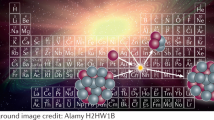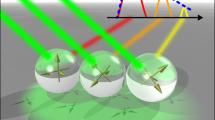Abstract
IT is universally assumed that the atom of an element can form a Saturnian system with more than one ring of rotating electrons, and this idea is used in particular by Moseley in the theoretical discussion of his recent experiments. But in an Adams prize essay, not yet published in extenso, this is shown to be impossible. If the law of repulsion between two electrons, or of attraction between electron and nucleus, is that of the inverse square, more than one coplanar ring cannot exist. All the electrons in any plane must lie in the same ring, and even if they are in different planes, the radii of the rings must be nearly equal. A consideration of a simple case will illustrate this. For example, it is at first sight probable that the system in the accompanying diagram, consisting of two coplanar rings of three electrons each, symmetrically arranged with all the angles equal to 60°, can exist with some angular velocity ω, if the radii of the outer and inner rings are a and b, the latter being, much smaller than a. But it is easily shown that the conditions of steady rotation, of such a system are—
This is a preview of subscription content, access via your institution
Access options
Subscribe to this journal
Receive 51 print issues and online access
$199.00 per year
only $3.90 per issue
Buy this article
- Purchase on Springer Link
- Instant access to full article PDF
Prices may be subject to local taxes which are calculated during checkout
Similar content being viewed by others
Author information
Authors and Affiliations
Rights and permissions
About this article
Cite this article
NICHOLSON, J. Atomic Models and X-Ray Spectra . Nature 92, 583–584 (1914). https://doi.org/10.1038/092583a0
Issue Date:
DOI: https://doi.org/10.1038/092583a0
This article is cited by
-
Resisting the Bohr Atom: The Early British Opposition
Physics in Perspective (2011)
Comments
By submitting a comment you agree to abide by our Terms and Community Guidelines. If you find something abusive or that does not comply with our terms or guidelines please flag it as inappropriate.



